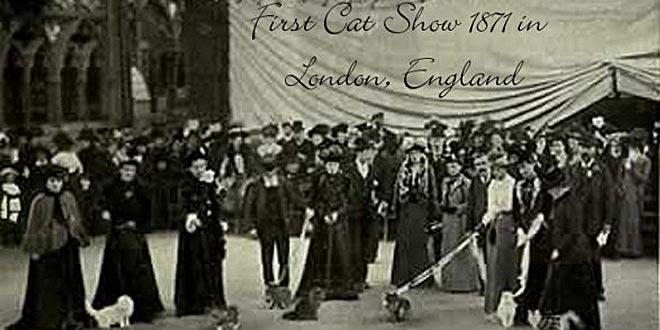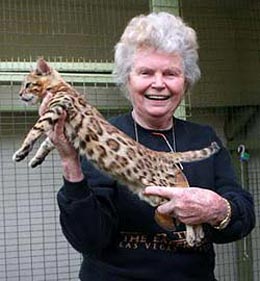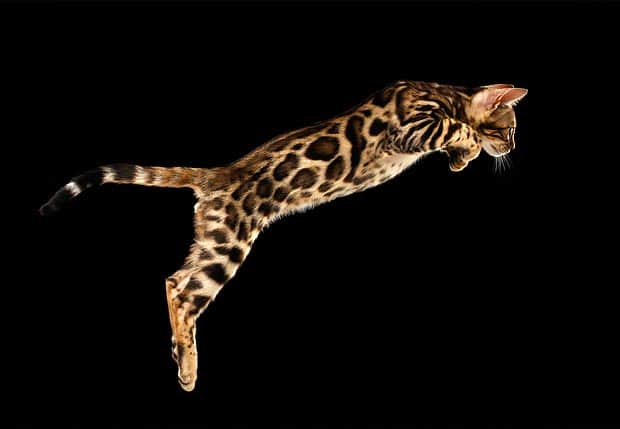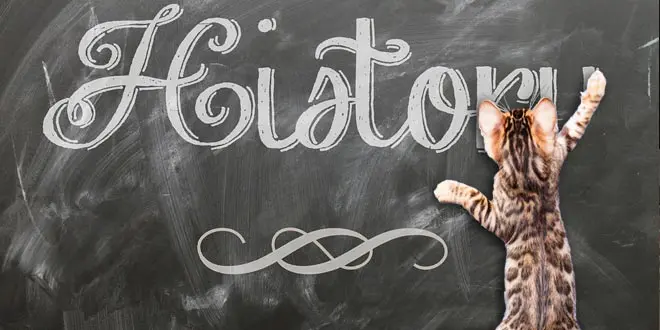[dropcap]M[/dropcap]any people assume that a cat is a cat – they do not realize that there are many unique breeds of cat out there, just as there are myriad different breeds of dog.
The Cat Fancier’s Association (CFA) recognizes 41 different cat breeds and The International Cat Association (TICA) recognizes sixty-three.
On top of these numbered breeds are a wide variety of hybrids and newly developed breeds which have yet to be recognized.
Many of these as-yet unrecognized breeds are hybrid species that have been selectively bred to give them a “wild” appearance similar to that of the wild leopard, or the Siberian tiger.
This plays on mankind’s fascination with taming the wild beast and keeping exotic animals as pets.
A Brief History of Cat Shows
Examples of this fascination have been put on display at cat shows around the world for more than a century.
The world’s first cat show was held at the Crystal Palace in London 1871.
This show featured many common breeds as well as some breeds with a more exotic appearance such as the Persian, the Siamese, and the Manx.
It wasn’t until the late 1870s, however, that hybrid cat breeds began to rise in popularity as cat fanciers started to breed domestic felines with smaller specimens of small wild cats.

At a cat show held in Edinburgh, Scotland in 1875 a wild Ocelot won the “Wild or Hybrid Between Wild and Domestic Cat” class.
Also on display at this show were other hybrids involving crosses of domestic cats with the Scottish wildcat (Felis silvestris) and the Caffre cat, currently known as the African wildcat (Felis silvestris lybica).
[highlight color=”orange”]Later, in 1889, the first crossing of a domestic cat with an Asian Leopard Cat (Felis bengalensis) occurred[/highlight] The details of this crossing were recorded by Harrison Weir in his book, Our Cats and All About Them.
This crossing marks the beginning of the development of the Bengal cat breed and it was the first of several such crossings to be recorded during the 1800s and early 1900s.
The Asian Leopard Cat
The Asian Leopard Cat (ALC) is a small wild cat species native to Southeast Asia.
This species reaches an average weight around 10 pounds (4 kg) and an average size around 16 inches (40 cm) with the addition of an 8-inch (20 cm) tail.
Asian Leopard Cats are similar in size to a large domestic cat but they have a distinctly wild appearance and a much more slender build.
The coat of this species is variable in terms of coloration and pattern, but most Asian Leopard Cats have a base color of brownish-yellow or silver-gray that fades to white on the throat and chest.
This species is covered with numerous black spots or rosettes which vary in pattern from one population to another.
The History of the Bengal Breeding Program
Though several crossings of the Asian Leopard Cat and the domestic feline occurred throughout the early 1900s, the real work of developing the Bengal breed didn’t begin until the 1960s.
Dr. Willard Centerwall, a professor of pediatrics and maternal health at the Loyala University Medical Center, was a cat fancier and studied feline genetics as a hobby.
Dr. Centerwall was fascinated with the Asian Leopard Cat because it was found to be resistant to the feline leukemia virus (FLV) and he was one of several researchers who were interested in studying whether or not the trait could be passed to hybrid offspring.

Around the same time, a cat breeder by the name of Jean Sugden Mill also began crossing the ALC with domestic felines, starting with her own solid black tomcat.
Mill’s motivation for creating a hybrid of the two was entirely different from Centerwall’s, however.
Whereas Centerwall was interested in manipulating feline genetics for health reasons, Mill’s interest was more aesthetic.
Mill sought to create a hybrid breed that had the appearance of a wild cat in hopes that people who supported the fur trade would find it more difficult to purchase furs if they were similar in appearance to their own pets.
In fact, Mill received her first Asian Leopard Cat specimen from Dr. Centerwall in 1980.
Mill and Centerwall were not the only two to show an interest in hybridizing wild cats with domestic felines.
In 1970, zoo keeper Bill Engler produced two litters of kittens he named “Bengals” by crossing his male Asian Leopard Cat, Shah, with two female domestic cats. Engler state that his purpose for creating such a hybrid was:
“to create a small exotic cat that was beautiful and that had the disposition that was suitable for a pet house cat”
Similar to Mill’s motivation for hybridizing wild and domestic cats, Engler sought to preserve exotic cat species which were becoming increasingly more endangered.
Engler is credited with coining the name “Bengal” cat, though the exact origins of the name are unclear.
Some suggest that it draws inspiration from the scientific name of the Asian Leopard Cat, Felis bengalensis, while others posit that it might be derived from his own name – B. Engler.
Engler may be credited with naming the Bengal cat, but it was only through Mill’s dedication and hard work that the breed came to be recognized by TICA.
Mill experienced several hiccups along the way, however.
The CFA accepted Leopard Cats for registration and breeding purposes in 1970, only to later ban them from registration.
In 1980, Mill restarted her breeding program in a renewed effort to domesticate the breed.
Her hard work was rewarded in 1983 when TICA accepted the Bengal cat for registration.
Once a rare and exotic breed, the Bengal is now one of the most frequently exhibited breeds in TICA shows.
Although Engler is responsible for naming the Bengal cat breed, no modern Bengal line in existence today can be traced back to his work.
In fact, in order to be an official Bengal cat today, the cat must be at least four generations removed from any ancestor with a wild bloodline.
This means that while modern Bengal cats maintain their wild appearance, they really only possess about 6% wild blood.
Some breeders continue to use Asian Leopard Cats in their breeding programs but most modern Bengals are not actually bred from the ALC but from established Bengal bloodlines.
In order to be shown in TICA shows, Bengal cats must have three consecutive generations of Bengal-to-Bengal breeding.
Bengal Cats Today
When it comes to the modern Bengal cat breed, the focus is often on the breed’s wild appearance.
In keeping with Engler’s goals, however, the Bengal is also a very gentle and affectionate breed.
Bengal cats do, in fact, possess the beauty of a wild cat but the temperament of a domestic cat.
Modern Bengals typically exhibit one of two fur patterns – the more common spotted pattern and a unique marbled pattern.
Both patterns exhibit similar tricolor markings with many spotted Bengals having rosettes that show a dark outline around each individual spot – this gives the cat the appearance of a wild jaguar.
Some spotted Bengals, however, have plain spots akin to the wild leopard.
Though any experienced breeder will admit that the Bengal cat is not much of a lap cat, the breed is still easy to tame and can be very affectionate.
Bengal cats do retain some of their hunting instincts leftover from their wild ancestry.
Bengal cats have also been known to hunt fish, a skill they retain from their Asian Leopard Cat heritage.
All in all, the Bengal cat is a playful and high-energy breed that enjoys active playtime.
This breed can be very mischievous at times and its intelligence can sometimes make it a challenge to manage.

One of the most defining characteristics of the Bengal breed is its muscular build and glittering coat.
This breed may be lithe and athletic, but it retains an air of grace as well.
The Bengal cat is generally a little larger than the average housecat with males of the breed weighing between 10 and 15 pounds (4.5 to 6.8 kg) and females weighing between 8 and 12 pounds (3.6 to 5.4 kg).
Bengals come in a variety of colors including blue, brown, silver, and white – there are also some that exhibit color points due in part to Siamese or Burmese in their bloodline.
It is also possible for Bengals to exhibit an all-black coloration known as melanistic – they still have marbling or spots but it can be difficult to see.
Through many years of selective breeding, the modern Bengal has been transformed from an exotic hybrid into a domestic breed.
Today, Bengal owners appreciate the breed’s playful and affectionate nature as well as its unique appearance.
These cats also tend to be very healthy and their beautiful coats are surprisingly easy to maintain.
All in all, the Bengal is a wonderful breed that any cat owner would be lucky to have.
[products limit=”3″ columns=”3″ orderby=”id” order=”DESC” visibility=”visible”]




